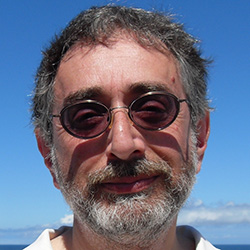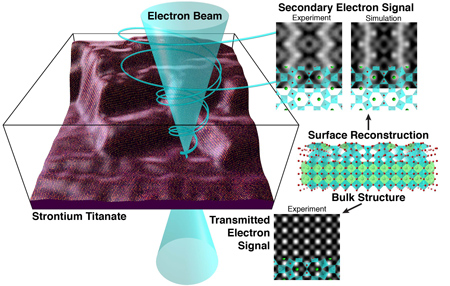A New Way to Image Surfaces on the Nanoscale
Method could be useful in developing green energy and a better understanding of rust
A multi-institutional team of scientists has taken an important step in understanding where atoms are located on the surfaces of rough materials, information that could be very useful in diverse commercial applications, such as developing green energy and understanding how materials rust.
Researchers from Northwestern University, Brookhaven National Laboratory, Lawrence Berkeley National Laboratory and the University of Melbourne, Australia, have developed a new imaging technique that uses atomic resolution secondary electron images in a quantitative way to determine the arrangement of atoms on the surface.
Many important processes take place at surfaces, ranging from the catalysis used to generate energy-dense fuels from sunlight and carbon dioxide to how bridges and airplanes corrode, or rust. Every material interacts with the world through its surface, which is often different in both structure and chemistry from the bulk of the material.
The study is published today (June 17) by the journal Nature Communications.
 “We are excited by the possibilities of applying our imaging technique to corrosion and catalysis problems,” said Laurence Marks, a co-author of the paper and a professor of materials science and engineering at Northwestern’s McCormick School of Engineering and Applied Science. “The cost of corrosion to industry and the military is enormous, and we do not understand everything that is taking place. We must learn more, so we can produce materials that will last longer.”
“We are excited by the possibilities of applying our imaging technique to corrosion and catalysis problems,” said Laurence Marks, a co-author of the paper and a professor of materials science and engineering at Northwestern’s McCormick School of Engineering and Applied Science. “The cost of corrosion to industry and the military is enormous, and we do not understand everything that is taking place. We must learn more, so we can produce materials that will last longer.”
To understand these processes and improve material performance, it is vital to know how the atoms are arranged on surfaces. While there are many good methods for obtaining this information for rather flat surfaces, most currently available tools are limited in what they can reveal when the surfaces are rough.
Scanning electron microscopes are widely used to produce images of many different materials, and roughness of the surface is not that important. Until very recently, instruments could not obtain clear atomic images of surfaces until a group at Brookhaven managed in 2011 to get the first images that seemed to show the surfaces very clearly. However, it was not clear to what extent they really were able to image the surface, as there was no theory for the imaging and many uncertainties.
The new work has answered all these questions, Marks said, providing a definitive way of understanding the surfaces in detail. What was needed was to use a carefully controlled sample of strontium titanate and perform a large range of different types of imaging to unravel the precise details of how secondary electron images are produced.
“We started this work by investigating a well-studied material,” said Jim Ciston, a staff scientist at Lawrence Berkeley National Laboratory and the lead author of the paper, who obtained the experimental images. “This new technique is so powerful that we had to revise much of what was already thought to be well-known. This is an exciting prospect because the surface of every material can act as its own nanomaterial coating, which can greatly change the chemistry and behavior.”
 “The beauty of the technique is that we can image surface atoms and bulk atoms simultaneously,” said Yimei Zhu, a scientist at Brookhaven National Laboratory. “Currently, no existing methods can achieve that.”
“The beauty of the technique is that we can image surface atoms and bulk atoms simultaneously,” said Yimei Zhu, a scientist at Brookhaven National Laboratory. “Currently, no existing methods can achieve that.”
Les Allen, who led the theoretical and modeling aspects of the new imaging technique in Melbourne, said, “We now have a sophisticated understanding of what the images mean. It now will be full steam ahead to apply them to many different types of problems.”
The U.S. Department of Energy (grant DE-FG02-01ER45945), the National Science Foundation (grant DMR-1206320) and the U.S. Department of Energy, Basic Energy Science, Material Science and Engineering Division (contract DE-AC02-98CH10886) supported the research.
The paper is titled “Surface Determination Through Atomically Resolved Secondary Electron Imaging.”
In addition to Marks, Ciston, Zhu and Allen, other authors are Pratik Koirala and Yuyuan Lin from Northwestern, Hamish Brown and Adrian D’Alfonso from the University of Melbourne, Yuya Suzuki and Hiromi Inada from Hitachi, and Colin Ophus from Lawrence Berkeley National Laboratory.